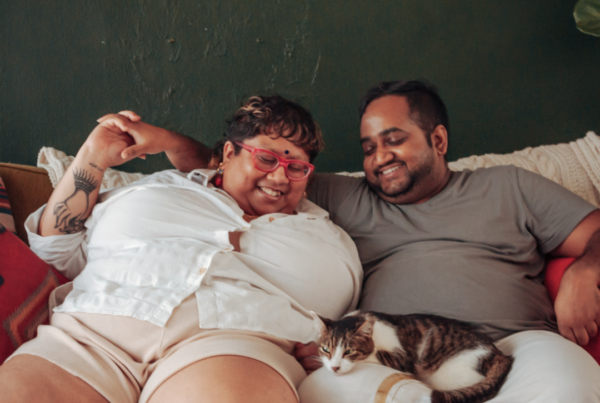Oooh the C word! Consent is not an easy concept to understand or explain. It is individual, experiential, cultural and contextual. And above all, it’s an evolving concept. Like in so many ways, human culture is going through a change in terms of personal space, individualism, age appropriateness and collective responsibility. Decades ago, our parents and caregivers lived in a so-called “simpler” time where personal space was not considered a right. But simple is not always good. It can be simple because we’re not considering others’ comfort, will and state of mind. We learn our basic code of conduct and etiquette from our caregivers. But unlearning problematic patterns and re-learning healthier ones is the core of self improvement. It might be difficult at first, but it makes us more connected, aware, informed and kind.
 Along with the #MeToo era, came the confusion regarding sexual consent. What’s okay? What is abuse? Can I do this? Why can’t I do that? To clear the confusion, it’s best to first think about consent outside of sexual intimacy, in our day to day activities and communication. Consent is not only for the bedroom; it’s a guiding principle that helps us be more in tune with others and respect their personal space. Consent is permission. It’s a right and a responsibility. Taking and giving consent is the cornerstone of mutual respect. It should be practiced in every relationship, for every activity. In Betty Martin’s Wheel of Consent, this concept is beautifully simplified. If you want something, ask before taking and confirm before accepting. If someone wants something from you, you decide if you want to give permission or service. Any interaction that happens without consent can easily fall under theft, cheating, entitlement or abusive behaviour. Not being allowed consent can make one endure abuse, become a doormat or victim of a wider range of abuses.
Along with the #MeToo era, came the confusion regarding sexual consent. What’s okay? What is abuse? Can I do this? Why can’t I do that? To clear the confusion, it’s best to first think about consent outside of sexual intimacy, in our day to day activities and communication. Consent is not only for the bedroom; it’s a guiding principle that helps us be more in tune with others and respect their personal space. Consent is permission. It’s a right and a responsibility. Taking and giving consent is the cornerstone of mutual respect. It should be practiced in every relationship, for every activity. In Betty Martin’s Wheel of Consent, this concept is beautifully simplified. If you want something, ask before taking and confirm before accepting. If someone wants something from you, you decide if you want to give permission or service. Any interaction that happens without consent can easily fall under theft, cheating, entitlement or abusive behaviour. Not being allowed consent can make one endure abuse, become a doormat or victim of a wider range of abuses.
 Here are a few simple ways you can ensure that consent is practiced in every interaction:
Here are a few simple ways you can ensure that consent is practiced in every interaction:
Ask and wait for a verbal yes- Consent is express, which means it should be a clear and quick yes. Not maybe, not thinking about it. An express agreement or permission is step one of consent. Nothing short of a verbal yes is a permission. Please don’t read signals or between the lines. Ask every time, a yes doesn’t come with a lifetime warranty. Ask for permission in every interaction irrespective of their age, gender, relationship with you or social standing. To assume a blanket “yes” to all your requests and demands is abusive. Movies and songs tell us that it’s okay to chase someone… when a young Shahrukh Khan sings, “tu haan kar ya naa kar, tu hai meri Kiran!” (whether you say yes or no, you’re mine!) is how youngsters learn to communicate and connect with their persons of interests. We must help our children practice consent, allow them to say no, express their wants, teach them to ask others for consent and respect it. Once you start practicing taking permission, it can slowly turn into your second nature and make you a more empathetic person. In a sexual context, always wait for the person to say yes verbally to your request. Not just when you begin, ask for permission before you introduce more intense levels to your intimacy like penetration, oral sex, kink etc. An interesting question is, can we accept agreement from an inebriated person? Let’s take the example of attending a meeting. Would you allow a person to make decisions in a meeting if they are drunk, under influence of any kind or unconscious? No, because you need a coherent, logical answer. Similarly, drunk or barely conscious people cannot give consent. It’s always sexier if you wait till they are back to normal before you engage sexually. Trust me, girls love that!
 Take a no gracefully- Consent is enthusiastic. A person shouldn’t have to say yes because they feel bad for you, or worse still, afraid of you! Enthusiastic and willing permission is step two of consent. There’s nothing less sexy than a person who can’t take no. Entitlement, gendered expectations, ego and sociocultural rules can make it difficult, especially men, to take no for an answer. Not taking a no in good faith can easily lead to stalking, harassment and even abuse. It’s difficult to teach kids to take a no when our media keeps glorifying heroes and role models who just can’t take no for an answer! The Netflix show You is just another one of generationally continuing content that asks you to “wear your interest down till they say yes.” So with media and power structures telling you to be a misogynistic person who doesn’t respect another’s feelings, it is upon us to be better. To teach our kids and ourselves to take a no gracefully, it’s okay to feel bad, it’s rejection or denial after all. It’s okay to feel sad, go home and hug yourself, maybe a treat, for respecting others even if it hurts you. Some examples of not taking a no with grace can be nagging, constant contact, negotiating, slandering the person, trying to meet or talk to them, messaging even when there is no reply, asking friends to intervene and creating public pieces of art that clearly defines your person of interest. These are perceived to be creepy behaviours that make a person feel unsafe and attacked. Please avoid any form of retaliation when someone says no.
Take a no gracefully- Consent is enthusiastic. A person shouldn’t have to say yes because they feel bad for you, or worse still, afraid of you! Enthusiastic and willing permission is step two of consent. There’s nothing less sexy than a person who can’t take no. Entitlement, gendered expectations, ego and sociocultural rules can make it difficult, especially men, to take no for an answer. Not taking a no in good faith can easily lead to stalking, harassment and even abuse. It’s difficult to teach kids to take a no when our media keeps glorifying heroes and role models who just can’t take no for an answer! The Netflix show You is just another one of generationally continuing content that asks you to “wear your interest down till they say yes.” So with media and power structures telling you to be a misogynistic person who doesn’t respect another’s feelings, it is upon us to be better. To teach our kids and ourselves to take a no gracefully, it’s okay to feel bad, it’s rejection or denial after all. It’s okay to feel sad, go home and hug yourself, maybe a treat, for respecting others even if it hurts you. Some examples of not taking a no with grace can be nagging, constant contact, negotiating, slandering the person, trying to meet or talk to them, messaging even when there is no reply, asking friends to intervene and creating public pieces of art that clearly defines your person of interest. These are perceived to be creepy behaviours that make a person feel unsafe and attacked. Please avoid any form of retaliation when someone says no.
 Check in- Consent is continuous. A person can say no during or at any point of an activity. Continuously giving permission throughout the interaction is the final and third step of consent. Can you leave a movie halfway through? Can you leave half of your dessert in the fridge? Can you decide to go to a party but then end it quickly because you don’t feel great? Similarly, a person can discontinue sexual intimacy at any point, at any time during. They don’t owe you complete sexual gratification at the cost of their physical or mental well being. You owe each other pleasure only as long as you both desire to do so. Pleasure cannot be one-sided, that’s abuse.
Check in- Consent is continuous. A person can say no during or at any point of an activity. Continuously giving permission throughout the interaction is the final and third step of consent. Can you leave a movie halfway through? Can you leave half of your dessert in the fridge? Can you decide to go to a party but then end it quickly because you don’t feel great? Similarly, a person can discontinue sexual intimacy at any point, at any time during. They don’t owe you complete sexual gratification at the cost of their physical or mental well being. You owe each other pleasure only as long as you both desire to do so. Pleasure cannot be one-sided, that’s abuse.
So that’s it. Consent is express, enthusiastic and continuous. If you ever feel that you have violated somebody’s consent, apologize to the person, don’t give excuses for it and make a mental note on how this happened. Next time, when would be a good moment to ask for permission? Watch this interesting video that explains it in an even simpler way for those who won’t take the hint and share it with the person you think needs a quick lesson in consent!





